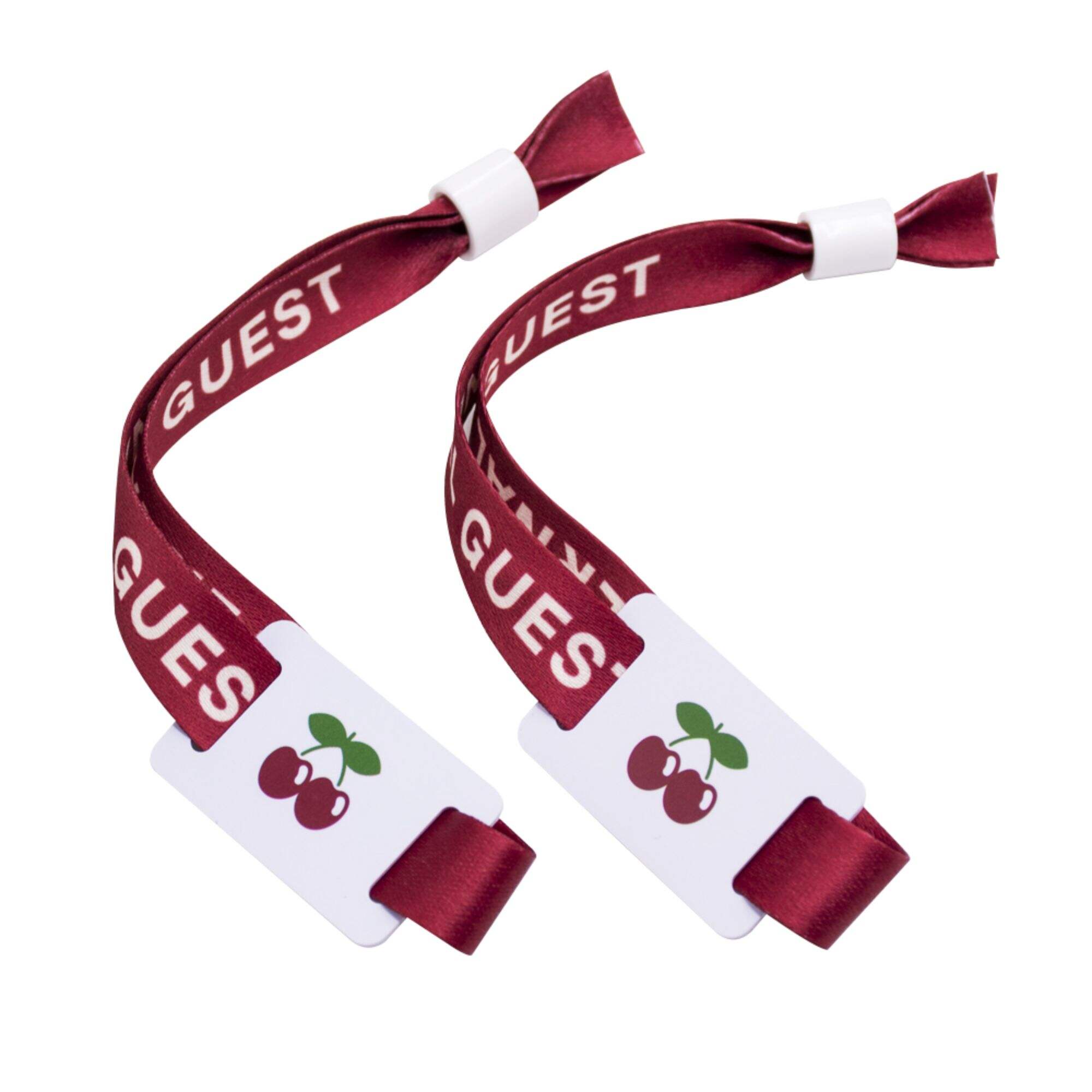The Advantages of RFID Bracelets in Secure Access Management
Enhanced Security Features of RFID Bracelets
Tamper-Evident Design for Access Control
The tamper-evident design of RFID bracelets plays a vital role in enhancing security by deterring unauthorized access. By providing visible indicators when tampered with, these bracelets alert security personnel to potential breaches. Typically made of tough materials such as heavy-duty laminates, these bracelets are both durable and effective in maintaining secure access control environments. According to recent studies, venues using tamper-evident technology have witnessed a significant reduction in unauthorized access incidents, highlighting the effectiveness of this approach. Not only does this design reinforce security, but it also provides peace of mind for both venue operators and attendees.
Encrypted Data Storage and Transmission
Encryption is the backbone of data security in RFID bracelets, ensuring that sensitive information remains confidential and protected from breaches. These bracelets typically use advanced encryption methods such as AES (Advanced Encryption Standard) to safeguard personal and secure access data. Reports indicate that strong encryption in RFID systems has successfully averted numerous data breaches, underscoring the importance of robust data security measures. By encrypting data storage and transmission, RFID technology not only protects user information but also enhances the overall security infrastructure of access control systems.
RFID vs Traditional Security Methods
RFID bracelets are a step ahead compared to traditional security methods like physical keys and ID cards. Unlike physical keys that can be lost or cards that can be duplicated, RFID bracelets are difficult to counterfeit and offer seamless access control. They provide significant advantages in both efficiency and cost-effectiveness by streamlining entry processes and reducing the need for manual checks. Experts in the security field praise RFID technology as a preferred choice, given its ability to enhance security while reducing operational costs for organizations across various sectors. As a testament to its growing popularity, more industries are adopting RFID for their security needs, leaning into its superior technology and convenience.## Streamlined Access Management Efficiency
Rapid Authentication in High-Traffic Scenarios
RFID technology has revolutionized the way we manage access in high-traffic environments by enabling rapid user authentication. In scenarios such as concerts, sporting events, and trade shows, where thousands of individuals need to be verified quickly, RFID systems provide an efficient solution. For example, events utilizing RFID wristbands see significantly reduced wait times compared to traditional ticket methods. A study highlighted that RFID technology can reduce entry times by up to 60%, allowing for better crowd management and improving overall attendee satisfaction. By streamlining the authentication process, venues can enhance safety while ensuring a more pleasant experience for their guests.
Reducing Human Error in Verification
Automation through RFID technology significantly diminishes human error in access verification processes. Traditional methods relying on manual checks are prone to mistakes, such as misreading or losing passes. RFID systems, however, automate this process, ensuring accurate and consistent verification every time. For example, airports using RFID for baggage tracking have experienced a dramatic reduction in lost luggage incidents. As a result, companies now require staff to understand RFID technology's essentials, often through training programs that cover system operation, troubleshooting, and maintenance. This investment in technology and training not only reduces errors but also boosts overall efficiency and reliability in access management.
Integration with Centralized Security Systems
RFID bracelets can seamlessly integrate with centralized security systems, enhancing overall management efficiency. By connecting RFID technology with existing systems like CCTV and alarms, organizations achieve comprehensive security oversight. For instance, an office using RFID bracelets for access control can link them with surveillance cameras to track entry and exit times, ensuring that only authorized personnel enter sensitive areas. A case study of a university implementing RFID in conjunction with its security system demonstrated improved incident response times and heightened campus safety. Such integration underscores the versatility and efficacy of RFID in bolstering security and providing more coordinated, proactive management solutions.## Customization for Diverse Applications
Adaptable Designs for Branding Needs
Customization is a powerful tool enabling businesses to transform RFID bracelets into brand ambassadors. With the ability to modify colors, shapes, and incorporate logos, companies can align these bracelets with their brand identity. Industries such as music festivals, sports events, and theme parks effectively use branded RFID wristbands to enhance customer experience. For example, during a popular festival, an organizer might issue RFID wristbands in the event's iconic colors, emblazoned with the festival's logo, creating a sense of belonging among attendees. Statistics show that customer engagement can significantly increase when brands use personalized products. Using such adaptable designs helps businesses leave a lasting impression on their audience through repeated visibility and interaction with the brand.
Material Options: From Waterproof to Reusable
Selecting the right material for RFID bracelets is crucial in meeting the functional needs and environmental objectives of different applications. The market offers an array of options, from waterproof to reusable materials. Waterproof RFID bracelets are ideal for water parks and resort environments, ensuring durability and longevity. In contrast, reusable options are perfect for events looking to align with eco-friendly practices. Manufacturers have demonstrated material performance, with case studies showing that waterproof RFID bracelets consistently withstand challenging environments without sacrificing functionality. As businesses are increasingly mindful of sustainability, selecting materials that balance performance and environmental impact becomes essential in today's market.
Customization Parallels with Food Packaging Labels
The intricacies involved in RFID customization find their parallel in the world of food packaging labels, as both sectors aim to improve branding and user experience. Just as food packaging labels can be tailored with specific information and eye-catching designs, RFID bracelets can be customized to enhance interactive experiences during events. Companies are utilizing trends from the packaging sector, like incorporating QR codes or NFC technology to offer additional digital experiences. Regulations in both fields influence how and what information can be displayed, ensuring that customization aligns with industry standards. RFID customization mirrors these trends, supporting unique branding opportunities while maintaining compliance with necessary regulations.## RFID With Chip Bracelet: Smart ID Management
In the realm of smart ID management, RFID bracelets are revolutionizing how businesses handle identification and access control. These sophisticated devices leverage RFID chip technology to offer seamless interaction and data management. By incorporating chips into wristbands, businesses can expand their functional scope from simple identification to complex applications in access control and cashless payments, exemplified by industry leaders like Great Wolf Lodge. Innovations in RFID chip technology have enabled bracelets to provide unique and unreplicable IDs, enhancing security and preventing impersonation. Such solutions have been successfully implemented in enterprises across various sectors, fostering efficiency and security in operations.
RFID Thermal Wristbands: Event-Ready Durability
Thermal RFID wristbands are the go-to solution for events, providing unmatched durability and convenience. Designed to withstand diverse climates and environmental conditions, these wristbands are both waterproof and robust, allowing usage underwater or in harsh weather conditions. This durability is particularly advantageous for events held in outdoor settings or areas susceptible to moisture. Moreover, statistics indicate high levels of customer satisfaction and repeat usage in events employing RFID thermal wristbands. The self-adhesive nature of these bands ensures they remain secure once applied, which enhances user experience and operational efficiency.
Industry-Specific Use Cases
Large-Scale Events and Venue Access
RFID bracelet systems have revolutionized the management of large-scale events, offering considerable logistical advantages. By enhancing venue access control and streamlining entry processes, RFID technology ensures that events run smoothly and securely. For instance, the Coachella Valley Music and Arts Festival successfully implemented RFID wristbands in 2019, which significantly reduced wait times and improved attendee satisfaction. Such systems not only ease congestion but also enable precise tracking of attendee flow, ensuring a well-managed, enjoyable experience for everyone involved.
The adoption of RFID technology at events offers substantial improvements in attendance management and payment efficiencies. With RFID wristbands, entry is as simple as a tap, eliminating manual checks that can lead to errors and delays. Additionally, payment processes become more efficient, as attendees use a simple wrist tap to purchase goods, enhancing both convenience and security. This efficiency often results in increased spending, benefiting event organizers with higher revenue.
Healthcare Facility Security
In healthcare facilities, RFID bracelets play a crucial role in enhancing security and operational efficiency. These bracelets ensure that only authorized individuals access sensitive areas, thereby safeguarding patient information and health data. Many hospitals have reported improved patient tracking and enhanced data security through the integration of RFID technology into their systems. For example, Massachusetts General Hospital has implemented RFID solutions for real-time patient tracking, which has significantly improved patient care and safety protocols.
Incorporating RFID bracelets in healthcare settings not only boosts security but also streamlines patient management. RFID technology provides hospitals with reliable tracking of patient movements, reducing the risk of misplaced patient records and ensuring timely treatments. Moreover, these bracelets are instrumental in automating attendance and access control, freeing up healthcare personnel to focus more on patient care rather than administrative duties.
Resort and Hospitality Integration
RFID technology offers significant benefits in the hospitality industry, particularly in enhancing the guest experience at resorts. By seamlessly integrating with booking systems and guest services, RFID bracelets simplify check-in processes, grant room access, and allow cashless transactions, thereby elevating overall guest satisfaction. Resorts utilizing RFID solutions report increased guest satisfaction, highlighting the technology’s role in delivering a personalized, hassle-free experience.
RFID bracelets also streamline various resort operations, from pool access to meal purchases, with just a wrist tap. This not only enhances convenience for guests but allows resort staff to provide more focused and personalized services. With integrations across various systems, automated data collection helps improve service offerings based on real-time guest patterns, leading to more targeted and efficient customer service.
 EN
EN
 AR
AR
 HR
HR
 CS
CS
 DA
DA
 NL
NL
 FI
FI
 FR
FR
 DE
DE
 EL
EL
 HI
HI
 IT
IT
 JA
JA
 KO
KO
 PL
PL
 PT
PT
 RU
RU
 ES
ES
 SV
SV
 TL
TL
 ID
ID
 SR
SR
 SK
SK
 SL
SL
 VI
VI
 HU
HU
 TH
TH
 TR
TR
 FA
FA
 AF
AF
 MS
MS
 IS
IS
 HY
HY
 BN
BN
 LO
LO
 LA
LA
 MN
MN
 MY
MY
 KK
KK
 UZ
UZ





